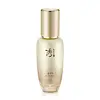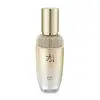What's inside
What's inside
 Key Ingredients
Key Ingredients

 Benefits
Benefits

 Concerns
Concerns

 Ingredients Side-by-side
Ingredients Side-by-side

Water
Skin ConditioningDipropylene Glycol
HumectantNiacinamide
SmoothingButylene Glycol
Humectant1,2-Hexanediol
Skin ConditioningPanax Ginseng Root Extract
EmollientGinsenosides
Skin ConditioningMorus Alba Bark Extract
Skin ConditioningOphiopogon Japonicus Root Extract
Skin ConditioningScutellaria Baicalensis Root Extract
AstringentPanthenol
Skin ConditioningPhenyl Trimethicone
Skin ConditioningTriethylhexanoin
MaskingPaeonia Suffruticosa Root Extract
Skin ProtectingAngelica Acutiloba Root Extract
Skin ConditioningPrunus Persica Kernel Extract
MoisturisingPaeonia Lactiflora Extract
AstringentPlantago Asiatica Extract
Skin ConditioningGlycyrrhiza Uralensis Root Extract
Skin ConditioningSchisandra Chinensis Fruit Extract
Skin ConditioningTricholoma Matsutake Extract
Skin ConditioningZingiber Officinale Root Extract
MaskingZanthoxylum Piperitum Fruit Extract
Skin ConditioningAtractylodes Japonica Rhizome Extract
Skin ConditioningCitrus Unshiu Peel Extract
MaskingPoncirus Trifoliata Fruit Extract
Skin ConditioningChaenomeles Sinensis Fruit Extract
AntioxidantDiospyros Kaki Leaf Extract
Skin ProtectingCinnamomum Cassia Bark Extract
MaskingArtemisia Princeps Leaf Extract
Skin ConditioningChrysanthellum Indicum Extract
Skin ConditioningCamellia Sinensis Leaf Extract
AntimicrobialPogostemon Cablin Leaf Extract
PerfumingPrunus Armeniaca Kernel Extract
Skin ConditioningPoria Cocos Sclerotium Extract
AstringentAngelica Tenuissima Root Extract
Skin ConditioningPhaseolus Radiatus Seed Extract
Skin ConditioningCeratonia Siliqua Fruit Extract
MaskingTrichosanthes Kirilowii Root Extract
Skin ProtectingLycium Chinense Fruit Extract
AntioxidantCornus Officinalis Fruit Extract
Skin ConditioningRehmannia Chinensis Root Extract
Skin ConditioningRehmannia Glutinosa Root Extract
Skin ConditioningHydroxypropyl Cyclodextrin
MaskingAdenosine
Skin ConditioningXanthan Gum
EmulsifyingSodium Polyacrylate
AbsorbentPotassium Acrylates/C10-30 Alkyl Acrylate Crosspolymer
Theobroma Cacao Extract
Skin ConditioningTromethamine
BufferingAroma
Water, Dipropylene Glycol, Niacinamide, Butylene Glycol, 1,2-Hexanediol, Panax Ginseng Root Extract, Ginsenosides, Morus Alba Bark Extract, Ophiopogon Japonicus Root Extract, Scutellaria Baicalensis Root Extract, Panthenol, Phenyl Trimethicone, Triethylhexanoin, Paeonia Suffruticosa Root Extract, Angelica Acutiloba Root Extract, Prunus Persica Kernel Extract, Paeonia Lactiflora Extract, Plantago Asiatica Extract, Glycyrrhiza Uralensis Root Extract, Schisandra Chinensis Fruit Extract, Tricholoma Matsutake Extract, Zingiber Officinale Root Extract, Zanthoxylum Piperitum Fruit Extract, Atractylodes Japonica Rhizome Extract, Citrus Unshiu Peel Extract, Poncirus Trifoliata Fruit Extract, Chaenomeles Sinensis Fruit Extract, Diospyros Kaki Leaf Extract, Cinnamomum Cassia Bark Extract, Artemisia Princeps Leaf Extract, Chrysanthellum Indicum Extract, Camellia Sinensis Leaf Extract, Pogostemon Cablin Leaf Extract, Prunus Armeniaca Kernel Extract, Poria Cocos Sclerotium Extract, Angelica Tenuissima Root Extract, Phaseolus Radiatus Seed Extract, Ceratonia Siliqua Fruit Extract, Trichosanthes Kirilowii Root Extract, Lycium Chinense Fruit Extract, Cornus Officinalis Fruit Extract, Rehmannia Chinensis Root Extract, Rehmannia Glutinosa Root Extract, Hydroxypropyl Cyclodextrin, Adenosine, Xanthan Gum, Sodium Polyacrylate, Potassium Acrylates/C10-30 Alkyl Acrylate Crosspolymer, Theobroma Cacao Extract, Tromethamine, Aroma
Water
Skin ConditioningGlycerin
HumectantDipropylene Glycol
HumectantPEG/PPG/Polybutylene Glycol-8/5/3 Glycerin
HumectantGlyceryl Polymethacrylate
Butylene Glycol
HumectantDimethicone
Emollient1,2-Hexanediol
Skin ConditioningPanthenol
Skin ConditioningPEG-150
HumectantBis-PEG-18 Methyl Ether Dimethyl Silane
EmollientMethyl Trimethicone
Skin ConditioningPhenyl Trimethicone
Skin ConditioningGinsenoside Rd
AntioxidantPanax Ginseng Root Extract
EmollientLactobacillus
Skin ConditioningLactobacillus Ferment
Skin ConditioningCurcuma Longa Root Extract
MaskingRoyal Jelly
Honey
HumectantNelumbo Nucifera Flower Extract
Skin ConditioningRosa Damascena Flower Extract
MaskingIris Ensata Extract
Skin ConditioningMineral Salts
Skin ConditioningBeta-Glucan
Skin ConditioningSodium Hyaluronate
HumectantCeramide NP
Skin ConditioningPEG-10 Rapeseed Sterol
CleansingArachidyl Glucoside
EmulsifyingButyrospermum Parkii Butter
Skin ConditioningCyclopentasiloxane
EmollientDimethiconol
EmollientPropylene Glycol
HumectantPolymethylsilsesquioxane
Squalane
EmollientMacadamia Ternifolia Seed Oil
EmollientTriethylhexanoin
MaskingHydrogenated Lecithin
EmulsifyingPEG-100 Stearate
Cholesterol
EmollientC14-22 Alcohols
Emulsion StabilisingStearic Acid
CleansingPEG-60 Hydrogenated Castor Oil
EmulsifyingChondrus Crispus Extract
Skin ConditioningAdenosine
Skin ConditioningAlgin
MaskingSodium Polyacrylate
AbsorbentAcrylates/C10-30 Alkyl Acrylate Crosspolymer
Emulsion StabilisingGlyceryl Stearate
EmollientGlycereth-20
HumectantTrisodium EDTA
Dextrin
AbsorbentTheobroma Cacao Extract
Skin ConditioningTromethamine
BufferingCarbomer
Emulsion StabilisingCI 19140
Cosmetic ColorantHc Yellow No. 4
Parfum
MaskingCitral
PerfumingCitronellol
PerfumingLimonene
PerfumingGeraniol
PerfumingLinalool
PerfumingWater, Glycerin, Dipropylene Glycol, PEG/PPG/Polybutylene Glycol-8/5/3 Glycerin, Glyceryl Polymethacrylate, Butylene Glycol, Dimethicone, 1,2-Hexanediol, Panthenol, PEG-150, Bis-PEG-18 Methyl Ether Dimethyl Silane, Methyl Trimethicone, Phenyl Trimethicone, Ginsenoside Rd, Panax Ginseng Root Extract, Lactobacillus, Lactobacillus Ferment, Curcuma Longa Root Extract, Royal Jelly, Honey, Nelumbo Nucifera Flower Extract, Rosa Damascena Flower Extract, Iris Ensata Extract, Mineral Salts, Beta-Glucan, Sodium Hyaluronate, Ceramide NP, PEG-10 Rapeseed Sterol, Arachidyl Glucoside, Butyrospermum Parkii Butter, Cyclopentasiloxane, Dimethiconol, Propylene Glycol, Polymethylsilsesquioxane, Squalane, Macadamia Ternifolia Seed Oil, Triethylhexanoin, Hydrogenated Lecithin, PEG-100 Stearate, Cholesterol, C14-22 Alcohols, Stearic Acid, PEG-60 Hydrogenated Castor Oil, Chondrus Crispus Extract, Adenosine, Algin, Sodium Polyacrylate, Acrylates/C10-30 Alkyl Acrylate Crosspolymer, Glyceryl Stearate, Glycereth-20, Trisodium EDTA, Dextrin, Theobroma Cacao Extract, Tromethamine, Carbomer, CI 19140, Hc Yellow No. 4, Parfum, Citral, Citronellol, Limonene, Geraniol, Linalool
Ingredients Explained
These ingredients are found in both products.
Ingredients higher up in an ingredient list are typically present in a larger amount.
1,2-Hexanediol is a synthetic liquid and another multi-functional powerhouse.
It is a:
- Humectant, drawing moisture into the skin
- Emollient, helping to soften skin
- Solvent, dispersing and stabilizing formulas
- Preservative booster, enhancing the antimicrobial activity of other preservatives
Adenosine is in every living organism. It is one of four components in nucleic acids that helps store our DNA.
Adenosine has many benefits when used. These benefits include hydrating the skin, smoothing skin, and reducing wrinkles. Once applied, adenosine increases collagen production. It also helps with improving firmness and tissue repair.
Studies have found adenosine may also help with wound healing.
In skincare products, Adenosine is usually derived from yeast.
Learn more about AdenosineButylene Glycol (or BG) is used within cosmetic products for a few different reasons:
Overall, Butylene Glycol is a safe and well-rounded ingredient that works well with other ingredients.
Though this ingredient works well with most skin types, some people with sensitive skin may experience a reaction such as allergic rashes, closed comedones, or itchiness.
Learn more about Butylene GlycolDipropylene Glycol is a synthetically created humectant, stabilizer, and solvent.
This ingredient helps:
Dipropylene glycol is technically an alcohol, but it belongs to the glycol family (often considered part of the ‘good’ alcohols). This means it is hydrating and gentle on skin unlike drying solvent alcohols like denatured alcohol.
As a masking agent, Dipropylene Glycol can be used to cover the smell of other ingredients. However, it does not have a scent.
Studies show Dipropylene Glycol is considered safe to use in skincare.
Learn more about Dipropylene GlycolGinseng root is a well-loved ingredient in Asian skincare for good reason. It hydrates the skin, soothes irritation, and helps even out skin tone.
In traditional East Asian medicine, ginseng has been used for centuries both as food and as a healing remedy, and modern research continues to confirm its skin benefits.
One of the standout features of ginseng is its ability to improve blood circulation and oxygen delivery to the skin, bringing a fresh supply of nutrients to support overall skin health. It also has antioxidant and anti-inflammatory properties. This helps to protect your skin against damage from UV exposure, pollution, and daily stress.
Additionally, studies suggest that ginseng may help reduce hyperpigmentation by inhibiting tyrosinase, the enzyme involved in melanin production.
There are different types of ginseng used in skincare, and while they all share core benefits, their potency can vary.
Most products use fresh or white ginseng because it’s more affordable. However, red ginseng, produced by steaming the root, contains higher levels of ginsenosides, which are compounds with proven anti-aging effects. These ginsenosides help reduce the appearance of wrinkles and improve skin elasticity.
Note: All forms of ginseng are listed simply as “Panax ginseng” in ingredient lists. We recommend reaching out to the brand if you have questions about which type of ginseng is used in their ingredients.
For general antioxidant benefits, any ginseng extract will do, but for wrinkle care or firmer skin, red or fermented ginseng is often more effective.
In short, ginseng is a powerhouse ingredient that supports hydration, radiance, and resilience.
Learn more about Panax Ginseng Root ExtractPanthenol is a common ingredient that helps hydrate and soothe the skin. It is found naturally in our skin and hair.
There are two forms of panthenol: D and L.
D-panthenol is also known as dexpanthenol. Most cosmetics use dexpanthenol or a mixture of D and L-panthenol.
Panthenol is famous due to its ability to go deeper into the skin's layers. Using this ingredient has numerous pros (and no cons):
Like hyaluronic acid, panthenol is a humectant. Humectants are able to bind and hold large amounts of water to keep skin hydrated.
This ingredient works well for wound healing. It works by increasing tissue in the wound and helps close open wounds.
Once oxidized, panthenol converts to pantothenic acid. Panthothenic acid is found in all living cells.
This ingredient is also referred to as pro-vitamin B5.
Learn more about PanthenolPhenyl Trimethicone is a silicon-based polymer. It is derived from silica.
Phenyl Trimethicone is used as an emollient and prevents products from foaming.
As an emollient, it helps trap moisture in the skin. It is considered an occlusive.
Learn more about Phenyl TrimethiconeSodium Polyacrylate is the sodium salt of polyacrylic acid. It is used as an absorber, emollient, and stabilizer.
This ingredient is a super-absorbent polymer - meaning it can absorb 100 to 1000 times its mass in water. As an emollient, Sodium Polyacrylate helps soften and soothe skin. Emollients work by creating a barrier to trap moisture in. This helps keep your skin hydrated.
This ingredient is extracted from the seeds of the cocoa tree.
Cacao seeds contain antioxidants known as polyphenols. These include flavonoids, procyanidins, and epicatechins.
Studies show these polyphenols help improve skin health.
The more famous ingredient from cocoa tree is cocoa butter.
Learn more about Theobroma Cacao ExtractTriethylhexanoin is created from glycerin and 2-ethylhexanoic acid. It is a solvent and emollient.
As a solvent, Triethylhexanoin helps dissolve ingredients to stable bases or help evenly distribute ingredients throughout the product.
It is also an emollient and helps condition the skin.
Learn more about TriethylhexanoinTromethamine helps balance the pH and improve the texture of a product. It is synthetically created.
As an emulsifier, Tromethamine prevents oil and water ingredients from separating. This helps stabilize the product and elongate a product's shelf life. Tromethamine also makes a product thicker.
Tromethamine helps balance the pH level of a product. Normal pH level of skin is slightly acidic (~4.75-5.5). The acidity of our skin is maintained by our glands and skin biome. Being slightly acidic allows our skin to create an "acid mantle". This acid mantle is a thin barrier that protects our skin from bacteria and contaminants.
Oral Tromethanmine is an anti-inflammatory drug but plays the role of masking, adding fragrance, and/or balancing pH in skincare.
1,3-Propanediol, 2-amino-2-(hydroxymethyl)-
Learn more about TromethamineWater. It's the most common cosmetic ingredient of all. You'll usually see it at the top of ingredient lists, meaning that it makes up the largest part of the product.
So why is it so popular? Water most often acts as a solvent - this means that it helps dissolve other ingredients into the formulation.
You'll also recognize water as that liquid we all need to stay alive. If you see this, drink a glass of water. Stay hydrated!
Learn more about Water